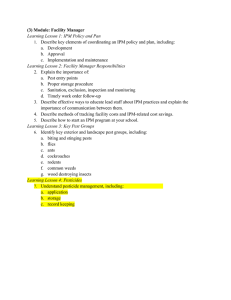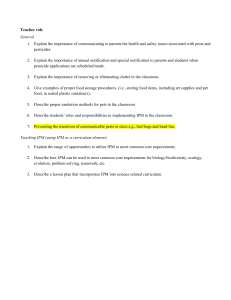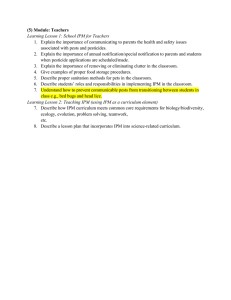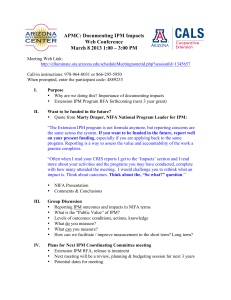Community IPM Team 3/2/11 Revised APMC Org Chart
advertisement
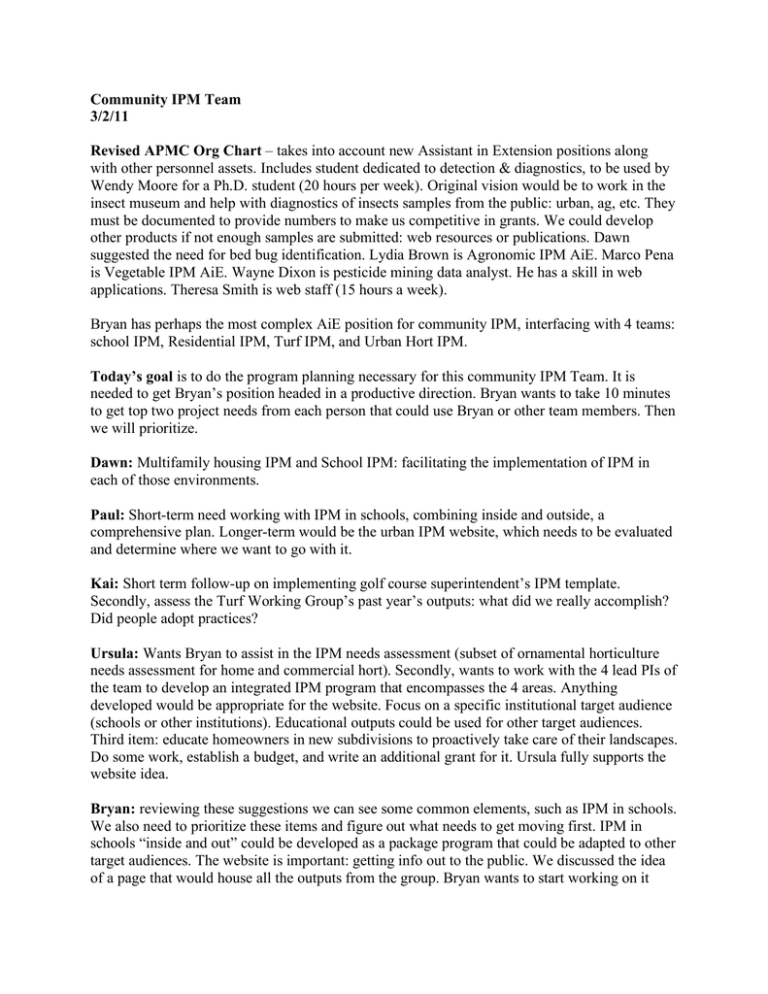
Community IPM Team 3/2/11 Revised APMC Org Chart – takes into account new Assistant in Extension positions along with other personnel assets. Includes student dedicated to detection & diagnostics, to be used by Wendy Moore for a Ph.D. student (20 hours per week). Original vision would be to work in the insect museum and help with diagnostics of insects samples from the public: urban, ag, etc. They must be documented to provide numbers to make us competitive in grants. We could develop other products if not enough samples are submitted: web resources or publications. Dawn suggested the need for bed bug identification. Lydia Brown is Agronomic IPM AiE. Marco Pena is Vegetable IPM AiE. Wayne Dixon is pesticide mining data analyst. He has a skill in web applications. Theresa Smith is web staff (15 hours a week). Bryan has perhaps the most complex AiE position for community IPM, interfacing with 4 teams: school IPM, Residential IPM, Turf IPM, and Urban Hort IPM. Today’s goal is to do the program planning necessary for this community IPM Team. It is needed to get Bryan’s position headed in a productive direction. Bryan wants to take 10 minutes to get top two project needs from each person that could use Bryan or other team members. Then we will prioritize. Dawn: Multifamily housing IPM and School IPM: facilitating the implementation of IPM in each of those environments. Paul: Short-term need working with IPM in schools, combining inside and outside, a comprehensive plan. Longer-term would be the urban IPM website, which needs to be evaluated and determine where we want to go with it. Kai: Short term follow-up on implementing golf course superintendent’s IPM template. Secondly, assess the Turf Working Group’s past year’s outputs: what did we really accomplish? Did people adopt practices? Ursula: Wants Bryan to assist in the IPM needs assessment (subset of ornamental horticulture needs assessment for home and commercial hort). Secondly, wants to work with the 4 lead PIs of the team to develop an integrated IPM program that encompasses the 4 areas. Anything developed would be appropriate for the website. Focus on a specific institutional target audience (schools or other institutions). Educational outputs could be used for other target audiences. Third item: educate homeowners in new subdivisions to proactively take care of their landscapes. Do some work, establish a budget, and write an additional grant for it. Ursula fully supports the website idea. Bryan: reviewing these suggestions we can see some common elements, such as IPM in schools. We also need to prioritize these items and figure out what needs to get moving first. IPM in schools “inside and out” could be developed as a package program that could be adapted to other target audiences. The website is important: getting info out to the public. We discussed the idea of a page that would house all the outputs from the group. Bryan wants to start working on it right away. The website could emulate the structure of the Org chart four outputs to the public. Al suggested a working group page for the community IPM team. #1: School / Institutional IPM inside and out (program) #2: Turf WG assessment (program assessment) #3: HOA program (program) #4: Horticulture IPM needs assessment (needs assessment) #5: Website (output) Next: set some short-term goals and timeline. Start by identifying what outcomes and impacts will be achieved in each of the 5 areas. Then plan specific activities. #1: School / Institutional IPM inside and out (program): Outcomes / Impacts: • Healthier site appropriate, functional landscapes with optimized pesticide use; part of this is reduced tree replacement cost • Reduction in pest exposure • Reduction pesticide exposures • (Schools use an Asthma Tracker): try to use this data to reduce asthma triggers • Must be at least cost neutral • Increase in awareness of environmental health and safety issues • Reduction in absenteeism • Reduction in injuries due to problems with ball fields • Reduced need for artificial shading environments • Optimal use of non-pesticidal inputs (including water use, fertilzer) • Improved air quality • Improved aesthetics / plant quality rating • Greater awareness of naturalist landscapes • Better awareness of living systems • Improvement in academic achievement is the real goal of school administrators; awareness by school administrators that healthier environments will lead to improved academic achievement. • Improve awareness, skills and attitudes of school staff and / or vendors if used for outdoor maintenance of turf and landscape. • Improved turf management practices. Outputs: • Write something for school districts that will improve awareness by school administrators that healthier environments will lead to improved academic achievement. • Involve parents and students involved in landscaping to increase their appreciation and knowledge / awareness of living systems and naturalistic landscapes. (This is like the SNAP program, what master gardeners are doing. There is a potential to involve these people and groups in “phase 2”.) • Get in touch with a few school districts and ask them which of these outcomes is important to them? Then revise work plan accordingly. Must limit ourselves to one or a few school districts (at least at first). Target Audiences / sites: • Schools • School administrators • School maintenance personnel • Parks and recreation personnel • Assisted care facilities! • Golf course superintendents and maintenance personnel Work with one school district in Tucson and in Phoenix areas, one or two golf courses, one assisted care facility. (Dawn left at 11:30.) Funding • Summer help? • Internships: sustainability. Train, then take home to local communities. • Americorp volunteer • ADA Risk Reduction program that promotes demonstrations to support adoption of reduced risk practices. Action Items • Bryan will follow up with the group to circulate the notes from this meeting and the plan for moving forward, get input and try to finalize the “logic model” for item #1. • Al will post notes to the team website. • Ursula will send team members the study she mentioned that links trees in the landscape to student academic performance. • Al will email the RFA for the ADA reduced risk program to the team members. Other priority areas for which logic models need to be developed: Plans will be discussed at the next meeting of the group. #2: Turf WG assessment (program assessment) Outcomes / Impacts: #3: HOA program (program) Outcomes / Impacts: #4: Horticulture IPM needs assessment (needs assessment) Outcomes / Impacts: #5: Website (output) Outcomes / Impacts:
